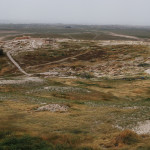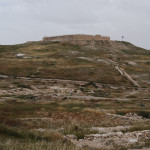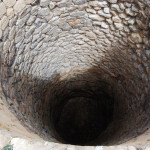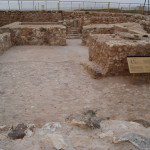Tel Arad National Park (Israel)
Tel Arad National Park and Archaeological Complex is situated in the western Negev Desert, Israel, close to the modern city of Arad.
Tel Arad National Park is divided into two parts – the lower one and the upper one. In the lower section there is an ancient city-fortress of Arad of the Canaanite period, in the upper part – a Jewish fortress with several buildings, including a temple, that date back to the times of King Solomon.
As the ancient city-fortress of the Canaanite period, Arad had a very fortunate location. The ancient road from Egypt to Mesopotamia went by Arad. At the end of the fourth millennium Before Christian Era a settlement was built here, and by the beginning of the third millennium BCE this settlement turned into a well fortified Canaanite city. The city was surrounded by a defensive wall made out of rustic stone 1,176 meters long, with round towers.
Public and residential facilities, numerous temples, and a small palace were located in the city. The residential houses all had an approximately similar inner layout. The entrance led from the street into a large room, benches were standing along the walls; in the centre of the facility there was a pillar for supporting the ceiling.
The city was supplied with water from the springs. This water was gathered in a big well that served as a water-collector, which was situated in the city’s centre. The citizens of Canaanite Arad were engaged in agriculture, they raised cattle, and, judging by the finds, had some commercial trade with Egypt. The presence of public buildings, temples, as well as figurines and different kinds of pottery discovered during the excavations, testifies to the high level of life in the Canaanite Arad. The ancient Arad existed from 3,000 till 2,650 BCE, and no one ever conquered or destroyed it – it was just abandoned by its dwellers, who, as they were leaving, took all their things with them.
The ruins of a fortress, a Jewish temple, and the buildings surrounding it, date back to the period of the Jewish presence in Arad, which began in the 11th century BCE. All these constructions are in the upper part of Tel Arad National Park.
The fortress occupied the area of 50 by 50 meters and was built in the years of King Solomon’s reign in the second half of the 10th century BCE. The construction of the fortress was carried out according to the standards and technologies of that time. A common type of walls was a casemate wall. It was formed by two walls, joined to one another by internal partition walls with rooms between them that are called casemates. They were filled with stones and dirt to make the walls more stable. Moreover, these walls allowed to lessen the damage done by sapping and battering rams. It was especially important after the Assyrians introduced an improved battering engine. One more advantage of the casemate walls is the flat roofs that enlarged the platform where the defenders of the wall could be stationed. Behind a casemate wall there was a safe area, because the enemy’s projectiles could not reach there.
Inside the fortress there are the remains of a storage facility that consisted of three long rooms, where wheat and oil were stored. A water reserve (cistern) cut in the rock, ten meters deep, with the capacity of 400 cubic meters was discovered here. The cistern of the Arad fortress has two halls with plastered walls. In the second hall there are stone steps that descended to the water. The water was used by the dwellers of the fortress both in peaceful times and under a siege, and also for the needs of the temple. If the water was short, they used the water from the well, which was in the centre of the lower, that is, the Canaanite city. The cistern was used in the 9th-8th centuries BCE.
The fortress of Arad is the only site on the territory of the former Kingdom of Judah, where a Jewish temple that date back to the 9th-8th centuries BCE was discovered.
The temple was oriented, like the Temple in Jerusalem, along the east-west axis. Opposite the entrance there was the first court with an altar; behind it there was a room with benches along the walls, and further inside – the “holy of holies”. The altar was made out of uncut stone and had the dimensions 2.20 by 2.40 meters. Animal sacrifices were offered at the altar, which is proved by a great number of bones found around the altar. There also was a groove for blood drainage on the altar. In the “holy of holies” of the temple a large stone and two decorated stone altars were discovered lying on their sides and covered with dirt. Here the worship services were conducted in the 9th-8th centuries BCE, then, maybe at the order of the king of Judah, in the 7th century BCE, the temple was filled with dirt, because all the offerings had to be made at the Temple in Jerusalem. Now the copies of the stone and two altars are set here, the originals are displayed in a museum in Jerusalem.
Many ostraca (pottery pieces with inscriptions made on them) were found on the territory of the fortress with the inscriptions in Hebrew, Aramaic, Greek and Arab languages. The Hebrew inscriptions date from the 9th-8th centuries BCE. These were the letters of a fortress’ commander concerning the matters of administrating the army: the directions to supply wine, bread, and oil to different forts, the lists of grain allowance, the complete record of storage facilities, and lists with names. An ostracon was found with an indication of a five-day allowance of wine for mercenaries who carried out the patrolling and escorting duties. A letter to the fortress commander was found with a request to send soldiers for protection from the Edomites. These finds prove that Arad was a state-fortress and a military and administrative centre of the region.
After the First Temple was destroyed in 586 BCE, Arad was still used by the Persians as a frontier fort. Later, both Greeks and Romans also used the fortress for military purposes. The next mention of Arad appears only in the 4th century AD. At that time it was a small village. On a mosaic Jordanian Madaba map of the 6th century AD there is an image of the fortress with the writing, “Arad – Aradians come from there.”
The new life of Arad began only in 1961, due to the development of the Negev desert.
2 комментария
Leave a Comment
You must be logged in to post a comment.







Непонятно почему люди ушли из такого благополучного города?
Вообще этот город большая загадка. Считается, что город по неизвестным причинам был оставлен около 5000 лет назад, около 3000 лет назад вновь заселен и опять оставлен. В городе и в его окрестностях археологи не нашли кладбища, а храм, обнаруженный в Араде, предположительно, является современником Первого Храма. Вот такие вот дела.